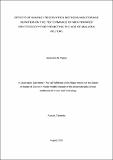Effects of sample preservation methods and storage duration on the performance of mid-infrared spectroscopy for predicting the age of malaria vectors
Abstract
The study assessed the effects of different preservation methods and storage durations on the
performance of mid-infrared spectroscopy for age-grading malaria transmitting mosquitoes.
Laboratory-reared Anopheles arabiensis (N=3,681) were collected as 5 or 17-day olds
and killed with ethanol then preserved using either silica desiccant at 5°C, freezing at -20°C,
or absolute ethanol at room temperatures. For each preservation method, the mosquitoes were
divided into three groups and stored for 1, 4 or 8 weeks, then scanned using the mid-infrared
spectrometer. Supervised machine learning classifiers were trained with the infrared spectra,
and used to predict the mosquito ages. The classification of mosquito ages (as 5 or 17-day
old’s) was most accurate when the samples used to train the models and samples being tested
were preserved the same way or stored for equal durations. However, when the test and
training samples were handled differently, the classification accuracies declined significantly.
Support vector machine classifiers (SVM) trained using spectra of silica-preserved
mosquitoes achieved 95% accuracy when predicting the ages of other silica-preserved
mosquitoes, but this declined to 72% and 66% when age-classifying mosquitoes preserved
using ethanol and freezing. Similarly, models trained on one-week stored samples had
declining accuracies of 97%, 83% and 72% when predicting ages of mosquitoes stored for 1,
4 or 8 weeks respectively. When using mid-infrared spectroscopy and supervised machine
learning to age-grade mosquitoes, the highest accuracies are achieved when the training and
test samples are preserved the same way and stored for the same durations. Protocols for
infrared-based entomological studies should emphasize standardization of sample-handling
procedures.

